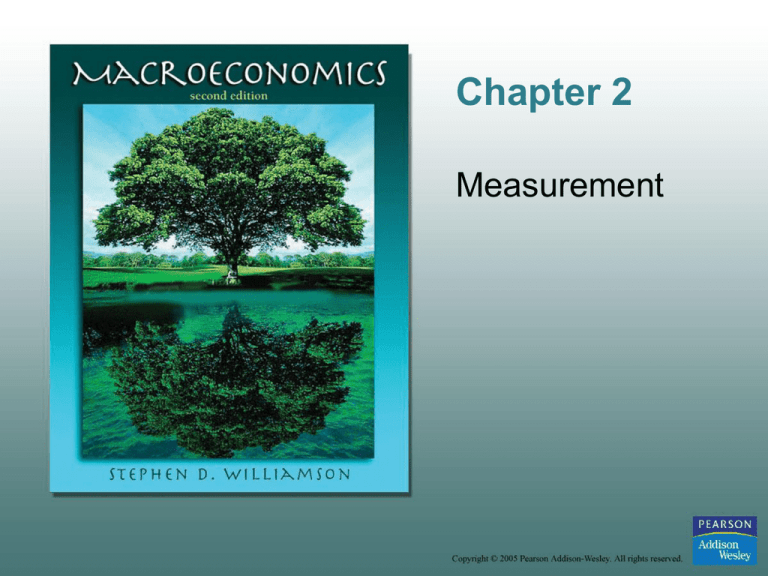
Chapter 2
Measurement
Measuring GDP: The National
Income and Product Accounts
• What is GDP and How Do We Measure It?
– GDP: Value of Domestically Produced Output
– Commerce Department’s National Income and
Product Accounts (NIPA)
– Business, Consumer, and Government Accounting
• The Equivalence of Three Methods
Copyright © 2005 Pearson Addison-Wesley. All rights reserved.
2-2
A Simple Fictional Island Economy
Sectors: a coconut producer, a restaurant, consumers,
and a government
Coconut producer: produces 10 million coconut, each
sold at $2. 6 million go to the restaurant, remaining 4
go to the consumers.
Restaurant: sells $30 million meals
Government: provides protection from attacks from
other islands. It collects taxes ($4.5 million from firms,
1 million from consumers).
Consumers: work for the business and government,
receive interest, pay taxes.
Copyright © 2005 Pearson Addison-Wesley. All rights reserved.
2-3
Table 2.1 Coconut Producer
Copyright © 2005 Pearson Addison-Wesley. All rights reserved.
2-4
Table 2.2 Restaurant
Copyright © 2005 Pearson Addison-Wesley. All rights reserved.
2-5
Table 2.3 After-Tax Profits
Copyright © 2005 Pearson Addison-Wesley. All rights reserved.
2-6
Table 2.4 Government
Copyright © 2005 Pearson Addison-Wesley. All rights reserved.
2-7
Table 2.5 Consumers
Copyright © 2005 Pearson Addison-Wesley. All rights reserved.
2-8
The Product Approach
• Value Added: VA = total revenue – the
value of intermediate goods
Copyright © 2005 Pearson Addison-Wesley. All rights reserved.
2-9
Table 2.6 GDP Using the
Product Approach
Copyright © 2005 Pearson Addison-Wesley. All rights reserved.
2-10
The Expenditure approach
• GDP = Consumption (C)
+ Investment
(I)
+ Government Expenditure (G)
+ Net Exports (NX=X-IM)
Copyright © 2005 Pearson Addison-Wesley. All rights reserved.
2-11
Table 2.7 GDP Using the
Expenditure Approach
Copyright © 2005 Pearson Addison-Wesley. All rights reserved.
2-12
The Income approach
• GDP = Wage Income
+ After-Tax Profits
+ Interest Income
+ Taxes
Copyright © 2005 Pearson Addison-Wesley. All rights reserved.
2-13
Table 2.8 GDP Using the
Income Approach
Copyright © 2005 Pearson Addison-Wesley. All rights reserved.
2-14
Add in Inventory Investment
Suppose now the coconut producer
produces 13 million instead 10 million,
but only sell out 10 million. What is GDP
now?
Answer: $49.5 million.
Copyright © 2005 Pearson Addison-Wesley. All rights reserved.
2-15
Add in International Trade
Suppose now the restaurant imports
additional 2 million coconuts from other
islands at $2 each. What is GDP now?
Answer: $39.5 million.
Copyright © 2005 Pearson Addison-Wesley. All rights reserved.
2-16
What is GNP?
• GNP = GDP + NFP
NFP: Net Factor Payments
= Factor payments to US citizens
- Factor payments to foreigners
Copyright © 2005 Pearson Addison-Wesley. All rights reserved.
2-17
What does GDP Leave Out?
• Nonmarket activity: home production,
leisure, ……
• Underground economy: illegal drug
trade, baby-sitting, ……
• Valuing Government Production
Copyright © 2005 Pearson Addison-Wesley. All rights reserved.
2-18
Table 2.9 Gross Domestic
Product for 2002
Copyright © 2005 Pearson Addison-Wesley. All rights reserved.
2-19
Nominal and Real GDP and Price
Indices
• Nominal GDP: GDP at current price
• Real GDP: GDP corrected for inflation
Copyright © 2005 Pearson Addison-Wesley. All rights reserved.
2-20
Table 2.10 Real GDP: Example
Copyright © 2005 Pearson Addison-Wesley. All rights reserved.
2-21
Nominal GDP
GDP1 = $130, GDP2 = $292
Change = (GDP2-GDP1)/GDP1 = 225%
Real GDP
Base year 1: RGDP1 = $130, RGDP2 = $176
Change (g1) = 35.4%
Base year 2: RGDP1 = $222.50, RGDP2 = $292
Change (g2) = 31.2%
Copyright © 2005 Pearson Addison-Wesley. All rights reserved.
2-22
Chain-Weighting Scheme
gc g1 g2
Copyright © 2005 Pearson Addison-Wesley. All rights reserved.
2-23
Figure 2.1 Nominal GDP (black line) and
Chain-Weighted Real GDP(colored line) for
the Period 1947–2003
Copyright © 2005 Pearson Addison-Wesley. All rights reserved.
2-24
Measures of the Price Level
•Implicit GDP Price Deflator
= (Nominal GDP / Real GDP) * 100
•CPI(t) = (Cost of base year quantities at
prices of year t / Cost of base year
quantities at base year prices) * 100
Copyright © 2005 Pearson Addison-Wesley. All rights reserved.
2-25
Table 2.11 Implicit GDP Price
Deflators: Example Cont’d
Copyright © 2005 Pearson Addison-Wesley. All rights reserved.
2-26
Figure 2.2 Inflation Rate Calculated from the
CPI (blue line), and Calculated from the Implicit
GDP Price Deflator (black line).
Copyright © 2005 Pearson Addison-Wesley. All rights reserved.
2-27
Problems Measuring Real GDP
and Prices
• Substitution Biases: make CPI upward
biased.
• Accounting for Quality Changes:
increase in prices maybe reflect the
improvement in quality. Inflation is
biased upward.
• Treatment of Newly-Introduced Goods:
bias downward GDP growth, upward
the inflation
Copyright © 2005 Pearson Addison-Wesley. All rights reserved.
2-28
Measures of Savings, Wealth, and
Capital
• Flow: a rate (change) per unit of time
– Saving, Investment, Consumption, …
• Stock: the quantity in existence of some
object at a point in time
– Capital, Wealth, …
Copyright © 2005 Pearson Addison-Wesley. All rights reserved.
2-29
Private Disposable Income and
Private Sector Saving
Y Y NFP TR INT T
d
S Y C
p
Copyright © 2005 Pearson Addison-Wesley. All rights reserved.
d
2-30
Government Surpluses, Deficits,
and Government Saving
S T TR INT G
g
S S S Y NFP C G
p
g
Copyright © 2005 Pearson Addison-Wesley. All rights reserved.
2-31
Saving, Investment, and the
Current Account
S I NX NFP
CA NX NFP S I CA
Copyright © 2005 Pearson Addison-Wesley. All rights reserved.
2-32
S Wealth
I K
CA Claims on Foreigners
Copyright © 2005 Pearson Addison-Wesley. All rights reserved.
2-33
Labor Market Measurement
• BLS Categories
– Employed
– Unemployed: unemployed during the past
week but actively searched for work during
the last four weeks
– Not in the Labor Force
Copyright © 2005 Pearson Addison-Wesley. All rights reserved.
2-34
• The Unemployment Rate =
Number unemployed / Labor force
• Participation Rate =
Labor force / Total working age
population
Copyright © 2005 Pearson Addison-Wesley. All rights reserved.
2-35







